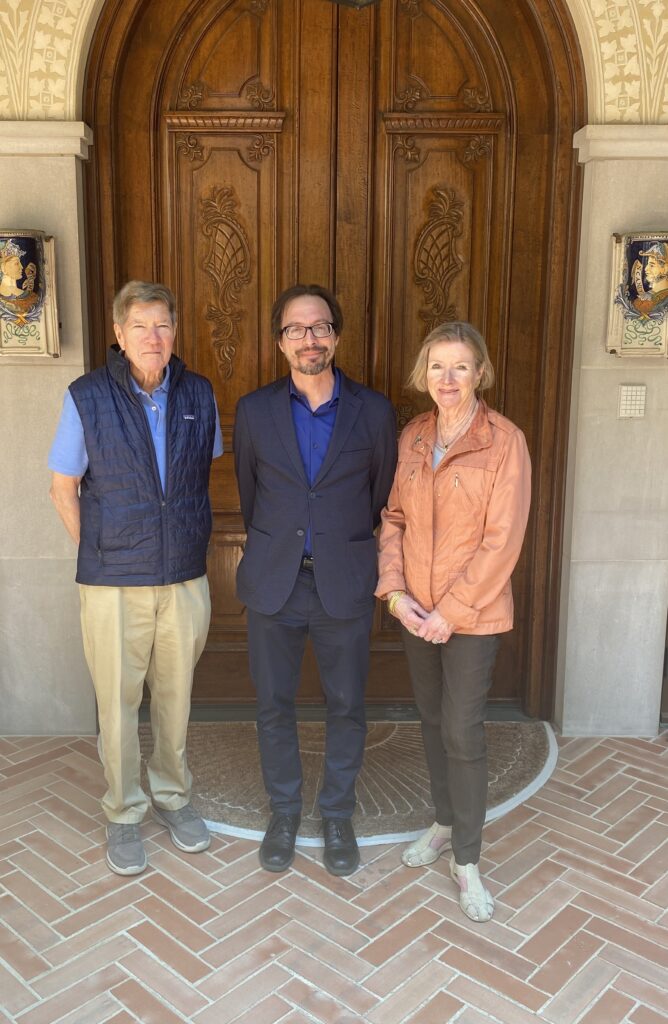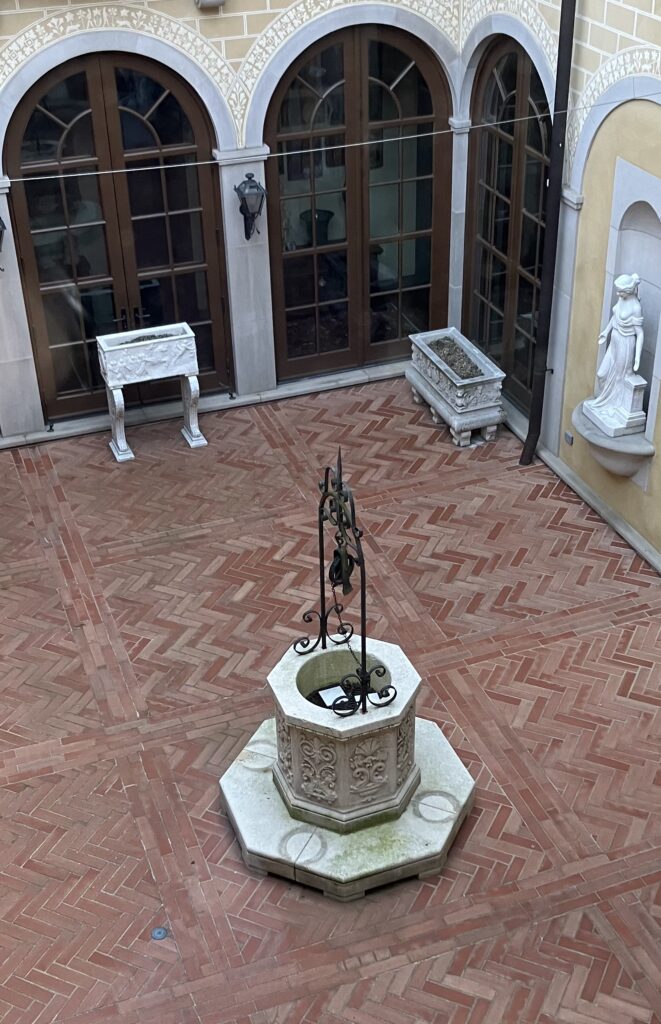
By David A. F. Sweet
When opening the hand-carved front door of the Krebs Center for the Humanities, one realizes the newest addition to Lake Forest College is far from the typical classroom building.

Rob Krebs (left) and Anne Krebs donated their house to Lake Forest College. Davis Schneiderman of the college is the center’s founding executive director.
Your first steps into the abode, finished in 2002, touch the pavers of an Italian-inspired courtyard. Inside, Renaissance paintings greet the eye.
“It’s a visual feast,” said Davis Schneiderman, founding executive director of the center, which is expected to begin its first full year of operations during the 2024-2025 academic year.
Anne and Robert Krebs built the Italian-villa replica on Walden Road on vacant land that was once part of the estate owned by Cyrus McCormick Jr. Why create a house in Lake Forest in this style?
The story begins when Krebs was a sophomore at Stanford University. He attended the school’s program in Florence – the first time he had left his native California.
“It changed my life,” he said. “My attendance opened my eyes to the events and history that formed Western civilization and gave me a lasting appreciation of the arts, starting with the masterpieces produced during the Renaissance.”
When he later took his wife Anne to Italy on a whirlwind tour, he talked with her about various painters and the Renaissance. Overwhelmed by her husband’s knowledge and realizing she needed to have a broader understanding of his passion, she took a pass/fail class about the Renaissance at Lake Forest College.
“I passed,” she said, “and then I told Rob, ‘Now, you need to take me back there.’”
Eventually, they bought a place in Italy with two other couples in the late 1980s. Originally just two towers built in the 11th century, it had since become a villa. A German art critic bought it in the 20th century.
“He had a bad gambling habit, and every time he lost, he gave away part of the villa,” Rob said. By the time the Krebs would arrive for two-week stays, they were surrounded by Italians who owned other parts of the villa.
The couple started taking Italian language lessons. They also joined Friends of Florence, where they got to know many people.
“The Italian membership gave all the parties,” Rob recalled, “and the Americans gave all the money.”
They decided they wanted to build an Italian villa in Lake Forest. The plot of land they found was only a few hundred yards from where another Italian-inspired formation had been created. Solomon Byron Smith and his wife, Barbara Neff Smith, constructed a hillside cascading fountain on the front lawn of their Mayflower Road home sometime in the 1960s. It was based on the cascading fountain they saw when staying at the Villa D’Este on Lake Como, Italy. (The hillside has since been removed.)

The graceful courtyard greets visitors after they enter the front door.
The Krebs hired local architect David Poulton. They traveled to Italy twice with him, and they bought stone there, where it was cheaper at the time (the fireplaces, in fact, were built in Florence). Within two years – with Rob and Anne stopping by nearly every day to see the progress – the villa was finished.
Amazingly, they decorated the thousands of square feet themselves, with no help from an interior decorator (“We know what we like,” Anne explained). They told painters how they wanted the ceilings to look – one is an exact replica of their Florentine villa, while another is modeled after the Doge’s Palace in Venice. On a ceiling just off the courtyard rests the Krebs’ family crest with five crabs (in German, Crabs means Krebs) and a railroad track, signifying Robert’s days as CEO of Burlington Northern Santa Fe.
Far from buying a number of paintings quickly to fill up the house, they spent many years looking for Old Master artwork and other creations from centuries ago. The living room features a piece from the 1400s by Cosimo Rosselli – “he was known as the worst painter on the Sistine Chapel,” Rob joked. In one cabinet in the dining room – Anne’s favorite room in the house – there are about two dozen blue Venetian glasses that look the same. On closer inspection, each one features a different stem.
“When we started out, we were just building a home,” Rob said. “Then we populated it, and it became a museum.”
Two-time chair of the board at Lake Forest College, Rob was pleased to donate the 9,000-square-foot house to the college earlier this year.
“I believe the backbone of education is liberal-arts colleges,” Rob said. “The humanities are a good foundation.”
When the gift was first proposed in 2013, some neighbors wrongly foresaw busses of college students descending on their bucolic area. In reality, only a handful will visit at any one time.

Many treasures adorn the walls of the new Lake Forest College center.
According to the college – whose main campus is within a short drive from its new building – the Krebs Center will have three pillars: The support and promotion of exceptional scholarship, excellent teaching, and public interest in and support for the arts and humanities.
Already, it’s had an impact.
“A domesticity in the Renaissance class came here for a field visit, and there were metaphorical jaws on the ground,” Schneiderman said. “You can do research about a painting in the collection or simply study the humanities here. It will all remain intimate in an appropriate way, in harmony with the neighborhood.”
Unsung Gems Columnist David A. F. Sweet can be reached at dafsweet@aol.com






